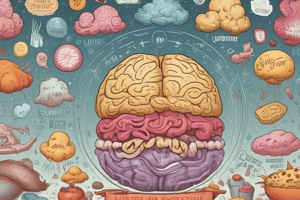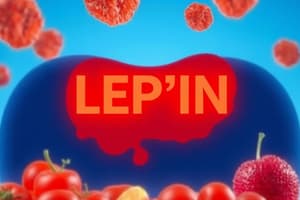Podcast
Questions and Answers
What is the primary function of leptin in the body?
What is the primary function of leptin in the body?
- Stimulating hunger
- Promoting fat cell growth
- Increasing insulin sensitivity
- Inhibiting hunger and stimulating satiety (correct)
What happens to leptin levels during fasting or dieting?
What happens to leptin levels during fasting or dieting?
- They increase significantly
- They fluctuate randomly
- They remain constant
- They drop markedly (correct)
Which type of fat cells secretes leptin into the bloodstream?
Which type of fat cells secretes leptin into the bloodstream?
- Brown fat cells
- Red fat cells
- Adipocyte progenitor cells
- White fat cells (correct)
What condition is associated with elevated leptin levels but does not regulate appetite effectively?
What condition is associated with elevated leptin levels but does not regulate appetite effectively?
What physiological process describes the body's effort to maintain a certain set point?
What physiological process describes the body's effort to maintain a certain set point?
Which brain region has been identified as having leptin receptors that play a role in regulating appetite?
Which brain region has been identified as having leptin receptors that play a role in regulating appetite?
In what way does the body respond if the fat storage exceeds the established set point?
In what way does the body respond if the fat storage exceeds the established set point?
What is a key characteristic of leptin secretion throughout the day?
What is a key characteristic of leptin secretion throughout the day?
What happens to liver and muscle cells in response to insulin?
What happens to liver and muscle cells in response to insulin?
Which of the following statements about Type II diabetes is correct?
Which of the following statements about Type II diabetes is correct?
What is a significant complication associated with Type I diabetes?
What is a significant complication associated with Type I diabetes?
How does artificially raising insulin levels before a meal affect hunger?
How does artificially raising insulin levels before a meal affect hunger?
What has been suggested as an alternative indicator for the glucostatic theory in hunger regulation?
What has been suggested as an alternative indicator for the glucostatic theory in hunger regulation?
Which statement best describes the relationship between blood sugar levels (BSL) and hunger according to the glucostatic theory?
Which statement best describes the relationship between blood sugar levels (BSL) and hunger according to the glucostatic theory?
What function does insulin primarily serve in the body?
What function does insulin primarily serve in the body?
What occurs when insulin levels rise during a meal?
What occurs when insulin levels rise during a meal?
Which role does insulin play in the body's energy needs?
Which role does insulin play in the body's energy needs?
What happens when glucose metabolism in the hypothalamus is disrupted?
What happens when glucose metabolism in the hypothalamus is disrupted?
Which factor is NOT mentioned as affecting food intake and satiation according to the content?
Which factor is NOT mentioned as affecting food intake and satiation according to the content?
What is a primary function of Cholecystokinin (CCK) in the body?
What is a primary function of Cholecystokinin (CCK) in the body?
Which condition must CCK meet to be considered involved in satiety?
Which condition must CCK meet to be considered involved in satiety?
How does CCK affect stomach emptying?
How does CCK affect stomach emptying?
In addition to CCK, which chemical is mentioned as a further satiating agent?
In addition to CCK, which chemical is mentioned as a further satiating agent?
What proportion of liquid food like soup is estimated to leave the stomach during the ingestion phase?
What proportion of liquid food like soup is estimated to leave the stomach during the ingestion phase?
Which statement best describes the role of the hippocampus in relation to food memories when full?
Which statement best describes the role of the hippocampus in relation to food memories when full?
How do Western style diets negatively impact the hippocampus?
How do Western style diets negatively impact the hippocampus?
Which neurotransmitter's increase is associated with a reduction in meal size?
Which neurotransmitter's increase is associated with a reduction in meal size?
What effect does Neuropeptide Y have on eating behavior?
What effect does Neuropeptide Y have on eating behavior?
What is a common side effect of drugs that affect serotonin and dopamine levels?
What is a common side effect of drugs that affect serotonin and dopamine levels?
Which method does serotonin use to aid in inducing satiation?
Which method does serotonin use to aid in inducing satiation?
What role does the hippocampus play when one is full?
What role does the hippocampus play when one is full?
Which of the following neurochemical effects is NOT directly related to appetite regulation?
Which of the following neurochemical effects is NOT directly related to appetite regulation?
What does the boundary model suggest about eating behavior?
What does the boundary model suggest about eating behavior?
How does the boundary model relate to disordered eating?
How does the boundary model relate to disordered eating?
What is a possible consequence of radical control of intake, such as in hunger strikes?
What is a possible consequence of radical control of intake, such as in hunger strikes?
What can be inferred about short-term energy regulation according to the extended boundary model?
What can be inferred about short-term energy regulation according to the extended boundary model?
Which statement best reflects the biological perspective on energy intake control?
Which statement best reflects the biological perspective on energy intake control?
What is the role of PYY in relation to eating behavior?
What is the role of PYY in relation to eating behavior?
How does grehlin affect the hypothalamus in terms of eating behavior?
How does grehlin affect the hypothalamus in terms of eating behavior?
What implications do knockout mice lacking the NY gene suggest about feeding regulation?
What implications do knockout mice lacking the NY gene suggest about feeding regulation?
What effect does corticotrophin releasing hormone (CRH) have on food intake?
What effect does corticotrophin releasing hormone (CRH) have on food intake?
How does Apolipoprotein A-IV affect appetite?
How does Apolipoprotein A-IV affect appetite?
In the interaction between peripheral and central mechanisms, how does leptin affect food intake?
In the interaction between peripheral and central mechanisms, how does leptin affect food intake?
What is a potential consequence of abnormally high levels of CRH?
What is a potential consequence of abnormally high levels of CRH?
Which of the following factors is NOT considered a biological variable influencing food intake?
Which of the following factors is NOT considered a biological variable influencing food intake?
Flashcards
Homeostasis
Homeostasis
The process of maintaining a stable internal environment within a set point, despite external changes.
Set Point
Set Point
A target value or range for a physiological variable like body temperature, blood sugar, or body fat.
Glucostatic Theory
Glucostatic Theory
A homeostatic model explaining hunger and satiety based on blood sugar levels.
Lipostatic Theory
Lipostatic Theory
Signup and view all the flashcards
Leptin
Leptin
Signup and view all the flashcards
White Fat Cells
White Fat Cells
Signup and view all the flashcards
Brown Fat Cells
Brown Fat Cells
Signup and view all the flashcards
Leptin Resistance
Leptin Resistance
Signup and view all the flashcards
Ob/ob Mice
Ob/ob Mice
Signup and view all the flashcards
db/db Mice
db/db Mice
Signup and view all the flashcards
Lipostatic Theory
Lipostatic Theory
Signup and view all the flashcards
Glucostatic Theory
Glucostatic Theory
Signup and view all the flashcards
Blood Sugar (BSL)
Blood Sugar (BSL)
Signup and view all the flashcards
Insulin
Insulin
Signup and view all the flashcards
Type I Diabetes
Type I Diabetes
Signup and view all the flashcards
Type II Diabetes
Type II Diabetes
Signup and view all the flashcards
Glycogen
Glycogen
Signup and view all the flashcards
Insulin's effect on appetite
Insulin's effect on appetite
Signup and view all the flashcards
Insulin's role in energy needs
Insulin's role in energy needs
Signup and view all the flashcards
Hypothalamic glucose metabolism
Hypothalamic glucose metabolism
Signup and view all the flashcards
Glucostatic theory limitations
Glucostatic theory limitations
Signup and view all the flashcards
Small intestine satiation
Small intestine satiation
Signup and view all the flashcards
Cholecystokinin (CCK)
Cholecystokinin (CCK)
Signup and view all the flashcards
CCK's function
CCK's function
Signup and view all the flashcards
CCK satiety criteria
CCK satiety criteria
Signup and view all the flashcards
Glucagon's role in satiety
Glucagon's role in satiety
Signup and view all the flashcards
Hippocampal State-Dependent Inhibition
Hippocampal State-Dependent Inhibition
Signup and view all the flashcards
Western Style Diet Damage
Western Style Diet Damage
Signup and view all the flashcards
Neurochemical Appetite Modulation
Neurochemical Appetite Modulation
Signup and view all the flashcards
Serotonin & Dopamine's Role
Serotonin & Dopamine's Role
Signup and view all the flashcards
Serotonergic Diet Drugs
Serotonergic Diet Drugs
Signup and view all the flashcards
Neuropeptide Y (NPY)
Neuropeptide Y (NPY)
Signup and view all the flashcards
Hippocampus and Food Intake
Hippocampus and Food Intake
Signup and view all the flashcards
Amnesia Data
Amnesia Data
Signup and view all the flashcards
Boundary Model
Boundary Model
Signup and view all the flashcards
Hunger Strikes
Hunger Strikes
Signup and view all the flashcards
Long-term Weight Control
Long-term Weight Control
Signup and view all the flashcards
Short-term Energy Regulation
Short-term Energy Regulation
Signup and view all the flashcards
Long-term Energy Regulation
Long-term Energy Regulation
Signup and view all the flashcards
Disordered Eating (Bingeing)
Disordered Eating (Bingeing)
Signup and view all the flashcards
Disordered Eating (Anorexia)
Disordered Eating (Anorexia)
Signup and view all the flashcards
Bobby Sands
Bobby Sands
Signup and view all the flashcards
PYY
PYY
Signup and view all the flashcards
Ghrelin
Ghrelin
Signup and view all the flashcards
NY
NY
Signup and view all the flashcards
Gut bypass surgery
Gut bypass surgery
Signup and view all the flashcards
Knockout mice (NY gene)
Knockout mice (NY gene)
Signup and view all the flashcards
CRH
CRH
Signup and view all the flashcards
Leptin's role in CRH
Leptin's role in CRH
Signup and view all the flashcards
ap-A-IV
ap-A-IV
Signup and view all the flashcards
Peripheral/Central Interaction
Peripheral/Central Interaction
Signup and view all the flashcards
Leptin and PVN
Leptin and PVN
Signup and view all the flashcards
CCK, Vagus, and VMH
CCK, Vagus, and VMH
Signup and view all the flashcards
Environmental Variables (food intake)
Environmental Variables (food intake)
Signup and view all the flashcards
Biological Variables (food intake)
Biological Variables (food intake)
Signup and view all the flashcards
Study Notes
Starting and Stopping Eating
- Peripheral factors influence starting and stopping eating.
- Digestion's consequences are being focused on.
- Food breakdown products, the body's response to them, and associated blood-borne chemicals are key.
- These have effects on hunger and satiety.
- Short and long-term energy regulation is considered.
Glucostatic Theory 1
- Glucose is the brain's primary energy source and for other cells.
- Blood sugar levels drop before meals and rise after.
- Presumed relationship between blood sugar levels and hunger/satiety.
Glucostatic Theory 2
- Mayer claimed that high arterial blood sugar with low venous blood sugar indicates no hunger.
- Low arterial blood sugar with low venous blood sugar indicates hunger.
- Significant correlations between blood sugar levels and hunger are observed.
- Injecting insulin (reducing blood sugar) triggers hunger.
- Reducing blood sugar by 50% leads to a 200% increase in caloric intake.
OK, but...
- Glucostatic theory works for daily energy needs, but not long-term weight regulation.
- Regulation of body weight is important for maintaining fat stores and responding to short-term food shortages/seasonal changes.
Lipostatic Theory
- Focuses on the need to maintain body weight over long periods, when food availability may fluctuate.
- The body's main energy storage during periods with limited food is fat.
- 1 kilogram of body fat is roughly equivalent to 7800 kcal.
- Humans typically have around 10% body fat, which represents approximately 20 days of energy.
- A set point concept is used to describe the body's weight maintenance mechanism.
Set Point
- The body works to restore a set point if there are changes from this point.
- Variables such as environmental and genetic factors can influence the set point.
- Processes such as pregnancy and puberty impact fat redistribution.
- Homeostasis is the process of maintaining this set point.
- Glucostatic and lipostatic theories are both homeostatic models.
Leptin 1
- Two types of fat cells exist in the body - brown fat and white fat.
- White fat cells store fat and secrete the hormone leptin into the bloodstream, levels of which reflect fat stores.
- The size of the fat cell is related to the amount of leptin it secretes.
Leptin 2
- Increasing leptin levels typically result in reduced hunger and increased feelings of fullness.
- Lower leptin levels stimulate appetite.
- In obese individuals, leptin levels may be high but the body may not respond appropriately (leptin resistance).
- There is evidence of a circadian rhythm to leptin secretion.
- Leptin levels are highest at night and lowest in the day.
Leptin 3
- Leptin deficiency can lead to obesity in mice (ob/ob mice) and humans.
- Injections of leptin can reverse the obesity in some human cases.
- Another type of mouse, db/ob, lacks leptin receptors and is also obese, but leptin injections are ineffective.
Leptin 4
- Circadian rhythm (daily cycle) influences leptin secretion.
- Leptin levels may be linked to eating patterns, especially in the case of Night Eating Syndrome. (circadian variation of leptin secretion might affect meal timing).
How Do These Theories Fair?
- Lipostatic theory is generally well-supported.
- Glucostatic theory has faced some issues.
- Blood sugar ratio and hunger may not always correlate well.
- Alternate indicators for set-point in blood sugar are explored.
- Insulin is considered as a potential factor that can influence blood sugar and appetite.
- Glucostatic theory might be only relevant at extreme conditions.
Insulin 1
- Insulin is a hormone regulating glucose metabolism.
- Insulin forces the liver and muscle cells to store glucose as glycogen.
- Promotes uptake of fats into fat cells.
- Blood sugar regulation is closely linked to insulin.
- Any abnormalities can be serious.
Insulin 2
- Type I diabetes is caused by a lack of insulin.
- Complications include neuropathy, ulcers, blindness, renal failure, and heart disease.
- Type II diabetes is also problematic and linked to body mass.
- Insulin resistance in the cells is involved.
Insulin 3
- Insulin affects appetite in complex ways.
- Artificially raising insulin levels before a meal can trigger hunger.
- A preparatory process, in response to food cues, may increase insulin signaling, leading to anticipatory hunger (and potentially over-eating).
- Artificially raising insulin levels during a meal can reduce food intake.
- This apparent contradiction illustrates the complexity of the system.
Cellular Glucose Metabolism
- Glucose metabolism in hypothalamus cells may be a marker indicating short-term energy needs.
- Several physiological and psychological processes contribute to eating, satiety and the signal that indicates satiety.
Satiating Agents—CCK
- Cholecystokinin (CCK) is a signal released by the gut.
- Stimulates the gallbladder contraction.
- May slow stomach emptying, influencing satiety.
- Higher protein and fat levels increase CCK release.
- CCK levels in lab rats reduce food intake.
- Demonstrates a role in satiety.
- Criteria for establishing an appetite-regulating chemical include release during feeding, effects from administration, congruent endogenous/exogenous dose, speed of clearing, and absence of other possible causes.
Satiating Agents—Glucagon
- Glucagon is a peptide released by the pancreas, opposing the effects of insulin, raising blood glucose.
- It stimulates glycogen breakdown in the liver, releasing glucose, and converts proteins into glucose.
- Injecting extra glucagon in humans or animals reduces food intake.
Food as a Satiating Agent
- Caloric density (energy content per unit of food), nutrient type, and texture contribute to feelings of fullness.
- Fatty foods initially reduce intake, but prolonged exposure can lead to enhanced intake through adaptations.
- Low-calorie foods (particularly for those habituated to certain types of food) may lead to increased intake.
- Protein-based foods are more filling than carbohydrate-based foods.
Texture
- Calorie-for-calorie, solid foods are more satiating than liquids.
- This may stem from differing rates of stomach emptying and differing sensory signals perceived from the various textures.
- Crunchy foods relate to slower eating rate and greater satiety.
Low Calorie Food
- Repeated exposure to low-calorie foods results in increased intake as flavors and familiarity signals increase food need.
- Associative learning is involved; a particular flavor triggers memories of low-calorie food, increasing the desire to eat similar foods.
Nutrient Type
- Calorie-for-calorie, protein-based foods are more filling than carbohydrate-based foods.
- The satiating effect might come from interactions in the small intestine.
Central Mechanisms
- Brain's role in hunger/satiety.
- Neurochemicals modulating appetite.
- Interaction between peripheral and central mechanisms.
- Conscious control of appetite.
- General models of appetite control.
The Case of “RD”
- Case study illustrating the importance of central mechanisms in eating regulation.
- He suffered from a craniopharyngioma, a brain tumor.
- The cyst pressed on the hypothalamus impacting appetite control.
- Subsequent removal of the cyst improved appetite regulation.
Craniopharyngioma
- Brain tumor typically occurring around the hypothalamus.
- Can cause severe obesity or emaciation.
- Long-term problems with weight regulation are potential consequences following surgery.
Hypothalamic Lesions
- Hetherington & Ranson (1940): Early research studying the effect of lesions on eating behavior in rats.
- Findings suggested that the hypothalamus plays a crucial role.
- Hyperphagia (excessive eating) and obesity were observed in some cases after hypothalamic lesions.
VMH as a Satiety Center
- Certain cells in the VMH are sensitive to blood sugar levels (insulin, metabolic status).
- Destruction of these cells leads to hyperphagia.
- Destruction of other areas in the VMH has a less impactful influence on eating behavior.
A Hunger Center
- A hunger center, specifically in or around the Lateral Hypothalamus (LH), has been identified.
- Damage to these cells results in reduced food intake or starvation.
- Stimulation results in increased food intake.
Stellar's Theory
- Stellar proposed the "brake" (ventromedial hypothalamic) and "accelerator" (lateral hypothalamic) concepts for controlling appetite.
And Now...
- Accumulated evidence for hypothalamic role in appetite.
- Some limitations and questions for continuing research, such as whether lesion sites affect only the targets or also the axons of the VMH/LH.
Target Behavior
- Cognitive abilities, such as learning and memory relating to eating behaviors may correlate to different brain targets.
Lesion location
- Specific lesions are difficult to achieve.
- There are effects beyond the intended site, including damage to axons, which could affect the result.
- Non-specific lesions often have larger and more unpredictable results than targeted ones.
Other Brain Areas
- Other brain areas beyond the hypothalamus are involved in feeding behavior management.
- Areas like the amygdala, insula cortex, orbitofrontal cortex, anterior cingulate cortex, and hippocampus are discussed.
Neuropsychology
- Cases of damage to different brain regions can reveal their role in eating behavior, such as in amnesia cases.
- Amnesia symptoms do not affect hunger and fullness perception.
- Amnesia can be involved with an individual’s inability to recall or process information including memories, events or facts.
Eating & Memory I and II
- HM, a patient with amnesia, could eat repeatedly on two subsequent occasions without recognizing he’d eaten before.
- This implies that memory plays a significant role in eating behavior regulation.
- Cognitive control of eating is likely more important than biological.
Eating and Memory III and IV
- Amnesiac people repeatedly eat despite the memory of having eaten and the biological satiety signals.
- The biological signal on satiety is not fully considered by conscious decision-making.
- Memory associated with past episodes might regulate how much someone is likely to eat in the future.
Eating and Memory V
- Limitations on the research to fully understand hippocampus function.
- The role of the hippocampus can not be fully understood, even if evidence of its likely involvement exists (which it does).
- Several factors influence food intake (social, sensory, biological, cognitive).
Neurochemicals
- Research focuses on neurochemicals that modulate appetite.
- Neurochemicals such as serotonin, dopamine, and neuropeptides (including neuropeptide Y (NPY), corticotrophin-releasing hormone (CRH) and apelin) are considered as crucial for controlling appetite.
Neurotransmitters
- Serotonin and dopamine levels affect meal size and frequency when administered in the brain’s lateral hypothalamus and ventromedial hypothalamus.
- The drugs that are used in psychiatry affect serotonin and dopamine.
- Alterations to these neurochemicals—with associated impacts on appetite and weight management—are prevalent in disorders like anorexia and obesity.
Neuromodulators I and II
- Neuropeptide Y (NPY) increases appetite and is stimulated by food intake.
- Corticotrophin-releasing factor (CRF) alters the set point of body weight and is regulated by leptin.
- Abnormal levels of CRH can impact appetite regulation.
Neuromodulators III
- Apolipoprotein A-IV (apo-A-IV).
- Its presence in the blood might reflect nutrient density, and it might be manufactured centrally in the brain.
Interaction of periphery & CNS
- Review of peripheral and central mechanisms.
- Focus on how peripheral signals and central processes interact regarding signals regarding food intake.
- Examples such as neurotransmitters and neuromodulators.
- Factors such as fat and the paraventricular hypothalamus are also considered.
Who is in Control of What I Eat?
- Environmental, biological, and conscious control factors influence food intake.
- These factors interact in complex ways.
- A boundary model is proposed where biological parameters provide the boundaries.
Extending the Boundary Model
- Both short term and long term factors influence the boundary of food intake.
Studying That Suits You
Use AI to generate personalized quizzes and flashcards to suit your learning preferences.




